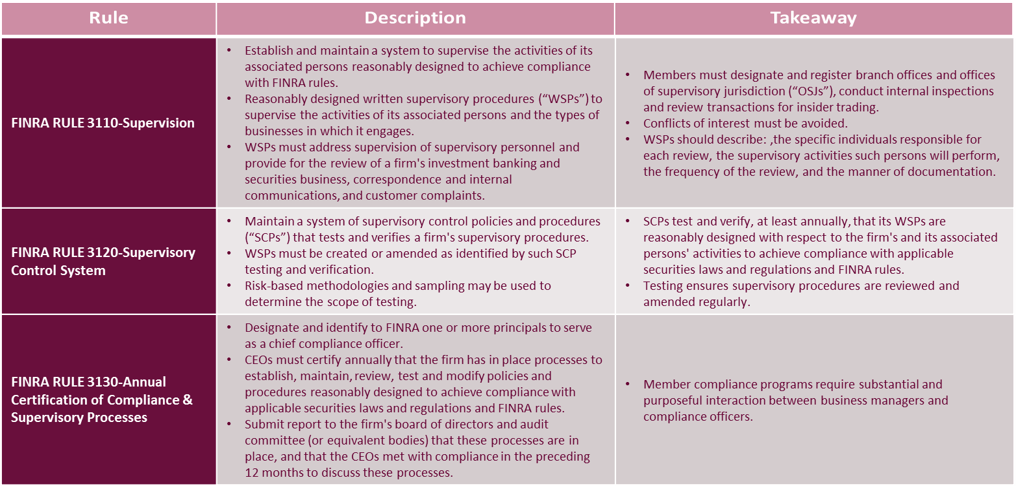Canadian Hydrogen Observatory: Insights to fuel…

FINRA requires all broker-dealers to have a supervisory framework in place that is “reasonably designed” to comply with applicable rules and regulations.
Challenges arise when a FINRA member attempts to supervise itself, including conflicts of interest and completing the Rule 3120 report, which are difficult to overcome without assistance.
The Financial Industry Regulatory Authority, Inc. (“FINRA”) Rules 3110, 3120 and 3130, together, mandate that all broker-dealers establish and maintain supervisory procedures appropriate for the member’s business, size, structure and customers. Specifically, each of the aforementioned FINRA Rules act as an element of a supervisory framework designed to ensure that member firms have procedures and controls in place which adequately address applicable rules, regulations and internal policies. This article will address each of these Rules in turn.
FINRA Rule 3110 lays the initial framework for self-supervision. More precisely, Rule 3110(a) requires members to have a supervisory system and written supervisory procedures that are reasonably designed to achieve compliance with applicable securities laws and regulations. This supervisory arrangement must be “reasonably designed” to comply with FINRA’s qualification requirements for persons acting in a supervisory capacity. In addition, Rule 3110(b)(6) requires controls to address the conflicts of interest of the associated person being supervised, such as the supervised person’s position, the amount of revenue such person generates for the firm or any compensation that the supervisor may derive from the associated person being supervised.
Rule 3110(b)(6) also prohibits supervisory personnel from overseeing their own activities, and reporting to, or having their compensation or continued employment determined by, a person or persons that they are supervising. As an exception to this prohibition, Rule 3110(b)(6)(C) permits a firm to allow this conflict if it determines that compliance is not possible because of the firm’s size or a supervisory personnel’s position within the firm. Each member firm must document the factors used to reach its determination, and how the supervisory arrangement (with respect to such supervisory personnel) complies with the Rule. In sum, the supervisory framework must be reasonably designed by the broker-dealer to supervise its employees’ conduct, while avoiding conflicts of interest
A high level overview of the supervisory rules and their takeaways are described in the below table.

FINRA Rule 3120 mandates documentation and reporting on the member firms’ supervisory framework. Under Rule 3120, member firms are required to create additional or amend supervisory procedures where the need is identified by such testing and verification. In addition, the designated principals must submit to the firm’s senior management, no less than annually, (1) a report detailing the firm's system of supervisory controls; and (2) a summary of the test results and significant identified exceptions, as well as any additional or amended supervisory procedures that have been created in response to those test results. Specifically, the report identifies the processes a firm follows to establish, maintain, review, test and modify its written compliance policies and written supervisory procedures.
This report must be also be submitted to the member's board of directors and audit committee (or equivalent bodies) in final form either prior to execution of the certification, or at the earlier of either their next scheduled meetings or within 45 days of the date of execution of the certification.
FINRA Rule 3130 requires member firms to establish the tone at the top. To do this, Rule 3130 requires members’ C-Suite personnel (i.e., CEO) to certify that the report adequately documents the member’s processes for establishing, maintaining, reviewing, testing and modifying compliance policies, which are reasonably designed to achieve compliance with applicable federal securities laws and regulations, including FINRA and MSRB rules.
Although FINRA lays out the requirements for establishing a supervisory framework, there are operational implications of compliance. First, member firms must independently identify the business activities that fall within the applicable rules, regulations and internal controls for each activity, as well as the associated persons that have supervisory responsibilities, and review the effectiveness of the firm’s supervision over these activities. Second, conflicts of interest must be identified, which could be difficult without performing an independent assessment. Third, member firms must ensure that they are capable for independently analyzing and testing of current supervisory procedures to determine if those procedures adequately address applicable rules, and establish new, or revise existing, supervisory procedures where deficiencies are noted.
An independent firm can assist member firms with navigation of these operational challenges by completing independent review and/or audits, and testing the member firm’s supervisory control procedures and supervisory system to determine where the firm may be at risk. The findings delivered by an independent assessor should be included in the Rule 3120 report that will detail the supervisory review, and also provide recommendations that will improve the broker-dealer’s compliance and operational controls. In addition, an independent firm can provide all firm personnel under supervision specialized training that addresses regulatory needs, including, but not limited to, anti-money laundering, asset and liability management, customer complaints, detecting and reporting customer complaints, and personnel supervision.
Broker-dealers are required by FINRA to have a supervisory framework in place that adequately address all applicable rules and regulations, depending on the size of the member firm. Member firms must ensure that not only their policies and procedures account for identifying issues, but that all gaps are properly documented and reported. Navigating these requirements while avoiding conflicts of interest can be challenging, and an independent firm may be in a better position to readily analyze and test supervisory procedures.
Broker-dealers must annually submit the following:
A report to the firm’s senior management that details the firm's system of supervisory controls.
Summary of the test results and significant identified exceptions, and any additional or amended supervisory procedures that have been created in response to those test results.
An independent assessment can assist with this report, and provide training and expertise to satisfy all applicable regulations.